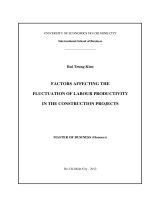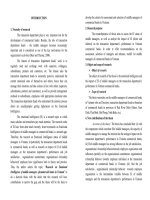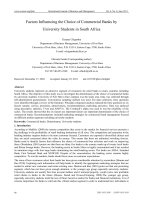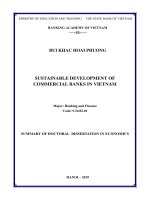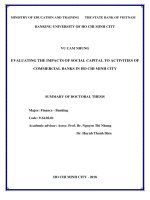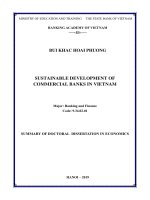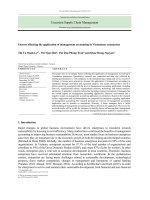Factors affecting the profitability of commercial banks in vietnam from 2009 2018
Bạn đang xem bản rút gọn của tài liệu. Xem và tải ngay bản đầy đủ của tài liệu tại đây (2.82 MB, 133 trang )
MINISTRY OF EDUCATION AND TRAINING STATE BANK OF VIETNAM
BANKING UNIVERSITY HO CHI MINH CITY
NGUYEN THI MINH THU
FACTORS AFFECTING THE PROFITABILITY OF
COMMERCIAL BANKS IN VIETNAM
FROM 2009 – 2018
GRADUATE THESIS
MAJOR: FINANCE - BANKING
CODE: 52340201
SUPERVISOR
MSC. VU THI HAI MINH
HO CHI MINH CITY, 2020
MINISTRY OF EDUCATION AND TRAINING STATE BANK OF VIETNAM
BANKING UNIVERSITY HO CHI MINH CITY
NGUYEN THI MINH THU
FACTORS AFFECTING THE PROFITABILITY OF
COMMERCIAL BANKS IN VIETNAM
FROM 2009 – 2018
GRADUATE THESIS
MAJOR: FINANCE - BANKING
CODE: 52340201
SUPERVISOR
MSC. VU THI HAI MINH
HO CHI MINH CITY, 2020
i
ABSTRACT
The purpose of this thesis is to provide an analysis of factors affecting the
profitability of 28 commercial banks in Vietnam from 2009 to 2018 using Pooled
OLS, FEM, REM, FGLS methods. The scope of the study is to aim at finding and
analyzing the degree of impact of specific bank factors, industry-specific factors
and macro-economic factors on the profitability of 28 commercial banks in
Vietnam. The study cannot avoid the limitations because of the selection may not
fully reflect the content and the meaning of all factors affect profitability or may not
fully represent all commercial banks in Vietnam.
Understanding the factors influencing the performance of the bank not only
receives much attention from scholars, but also from shareholders, administrators
and authorities, because it assists policy makers and administrators in formulating
strategies and policies to ensure the stability and sustainability of banking system's
operation, as well as to avoid the risk of banking system crisis. Assessing the
profitability of a commercial bank always raises questions, because of their
diversity. Many researchers consider that profitability can provide a picture of the
bank's business results.
Obtained result showed that ROA of commercial banks in Vietnam was
affected positively and statistically significant by bank size, equity ratio, loan ratio,
deposit ratio, income diversification ratio, credit growth rate and GDP; while nonperforming loan, operating cost and exchange rate have negative impact on ROA. In
contrast, liquidity, credit to GDP and inflation do not affect ROA and are not
statistically significant.
Keywords: commercial banks, profitability, ROA, bank size, nonperforming loan, equity ratio, liquidity ratio, loan ratio, deposit ratio, income
diversification ratio, operating cost, credit to GDP, credit growth rate, GDP,
inflation, exchange rate.
ii
SUMMARY
International economic integration is an indispensable trend and an objective
requirement for any country in the current development stage. However, this
process, in addition to creating certain advantages and opportunities for the country
participating in the integration, also put these countries before significant
difficulties and challenges. The roadmap of international economic integration puts
enterprises of developing countries in general, the commercial banking system in
particular and the new business environment with fierce competition pressures,
unbalanced competitors. Currently, Vietnam is a member of the United Nations, the
World Trade Organization, the International Monetary Fund, the World Bank
Group, the Asian Development Bank and the Joint Forum Economic Cooperation
Asia-Pacific, ASEAN. Vietnam participates in multilateral free trade agreements
with ASEAN countries, South Korea, Japan and China. Vietnam has also signed
with Japan a bilateral economic partnership agreement. For banking and monetary
system, the integration process is associated with the process of liberalizing
financial market, bringing many opportunities, but also many challenges. From that
practice, this thesis will analyze and introduce factors affecting the efficiency in the
operation of Vietnam’s commercial banking system in the current integration
period, especially the factors affecting the profitability of commercial banks in
Vietnam, from which to give practical recommendations to improve the operational
efficiency of commercial banking system, is an urgent issue.
This thesis analyses factors affecting the profitability of 28 commercial
banks in Vietnam from 2009 to 2018 using regression methods such as Pooled OLS,
FEM, REM, FGLS; thereby provide some recommendations to improve the
profitability of commercial banks in Vietnam.
In order to further analyze the impact of Vietnam's macro environment and
banking industry on the profitability of Vietnamese commercial banks, the author
decided to consider three more independent variables, namely exchange rate, credit
iii
to GDP and credit growth rate along with two familiar macro factors which are
inflation and GDP growth.
The table below summarizes related previous studies and theoretical
framework of this thesis.
Table 0.0.1: Related previous studies and theoretical framework
Theory/Related previous
studies
Subjects are mentioned
Commercial banks
Definition of commercial
banks
Definition of bank
profitability
Profitability
Measurement
Market power theory
Efficiency theory
Agency cost theory
It explains the profit of
firms to be increased from
the achievement of more
market power
It explains other aspect of
bank profitability which
can be generated from
better management and
business efficiency
This theory focuses on the
use of financing structure
Previous studies and
related law, decree
- Law: Consolidated
documents No.
20/2018/VBHN-NHNN,
the State Bank of Vietnam
- Previous studies: Getter,
(2016), Tariq et al. (2014),
Tuyishime et al. (2015),
Kalpana & Rao (2017),
Mongid et al. (2012),
Erina & Lace (2013)
Wang & Wang (2015),
Bikker & Vervliet (2017),
Iacobelli (2017), Yuksel
et al. (2018), Muya &
Gathogo (2016), Niresh &
Velnampy (2014),
Sehrish, Irshad & Khalid
(2010), Pastory &
Marobhe (2015), Kohler
(2013)
Book: Principals of
finance, Scott, B. &
Eugene, F. B. (2015)
Bain (1951)
Demsetz (1973)
Jensen & Meckling
iv
Signaling theory
Foreign studies
National studies
of the firms to drive the
managers and the
investors to solve free
cash flow issues
This theory emphasizes
that the firms with
profitable condition and
high business
Arrow (1972) and Spence
performance can supply
(1973)
the market and the
customers with positive
information
Almaqtari et al. (2018), Yao et al. (2018), Yuksel et al.
(2018), Kawshala & Panditharathna (2017), Nuhiu et
al. (2017), Pastory & Marobhe (2015), Sehrish Gul,
Faiza Irshad and Khalid Zaman (2011), Abuzar (2013),
Usman, D. (2014), Khaled, M. et.al (2016), Sufian, F.
& Noor-Mohamad-Noor, A. (2012), Al-Omar, H. &
Al-Mutairi, A. (2008)
Nguyen (2018), Nguyen et al. (2018), Le et al. (2017),
Nguyen, D. (2017), Phan & Phan (2014), Vo & Batten
(2014), Vu & Nahm (2013), Nguyen Thanh Phong
(2015), Phan Thi Hang Nga (2011)
Source: Author’s synthesis
The research model proposed specifically as follows:
Where: βo : constant term
β1, ..., β14: Regression coefficients for the independent variables
i: bank; t: year of observation; μi: error term/ residual term
Dependent variables:
ROA: return on assets (%)
Independent variables (bank-specific factors):
SIZE: bank size (billion VND)
NPL: non-performing loan (%)
LIQ: liquidity ratio (%)
v
EQR: equity ratio (%)
LOAN: loan ratio (%)
DEP: deposits ratio (%)
IDR: income diversification ratio (%)
OPR: operating cost ratio (%)
Independent variables (industry-specific factors):
CRD: credit to GDP
CGR: credit growth rate
Independent variables (macro-economic specific factors):
INF: inflation
GDP: gross domestic product
ER: exchange rate between VND and USD
The thesis performs: (1) Descriptive statistics; (2) Correlation analysis; (3)
Model estimation (Pooled OLS, FEM, REM); (4) Model choice (Between Pooled
OLS and FEM, between FEM and REM); (5) Model diagnostics (Autocorrelation
diagnostics, multicollinearity diagnostics, heteroskedasticity diagnostics); (6) Model
fix; (7) The prediction of residuals; (8) Normality test of residuals.
The result of model choice analysis showed that both FEM and REM were
more appropriate than Pooled OLS. Furthermore, FEM was proven as more
appropriate than REM. However, the author identified that there was
autocorrelation issue in the dataset. The result of heteroskedasticity check revealed
that FEM model did face up with this issue. To fix the model problems, the author
conducted FGLS regression technique and here is the result:
vi
However, while some independent variables are in line with the expectations
of the author, there are some independent variables that contrary to the author's
initial expectations. Detailed is shown as below:
Table 0.0.2: Expectations and research results of independent variables
Code
SIZE
NPL
LIQ
EQR
LOAN
DEP
IDR
OPR
CRD
CGR
GDP
INF
ER
Expected
Results
signs
Bank size
+
+
Non-performing loan
Liquidity ratio
No impact
Equity ratio
+
+
Loan ratio
+
+
Deposit ratio
+
+
Income diversification ratio
+
+
Operating cost ratio
Credit to GDP
+
No impact
Credit growth rate
+
+
Gross domestic product growth
+
+
Inflation rate
No impact
Exchange rate between VND and USD
(Source: Author’s synthesis)
Description
Based on the research results, the author will provide some recommendations
in chapter 5 to improve commercial banks’ profitability, thereby helping policy
makers to easily control and optimize the profitability of commercial banks.
vii
DECLARATION
I hereby declare that the graduate thesis is my original work, written by me
under the guidance of Ms. Vu Thi Hai Minh and it has not been presented for
examination in anywhere else. The data and sources cited in the thesis have been
duly acknowledged.
I take full responsibility for my pledge.
Author
Nguyen Thi Minh Thu
viii
ACKNOWLEDGEMENT
It is my radiant sentiment to place on record my best regards, deepest sense
of gratitude to my supervisor at Banking University in Ho Chi Minh City - Ms. Vu
Thi Hai Minh, for her patience, motivation, enthusiasm, and immense knowledge.
She has wholeheartedly helped and guided me in the process of writing this thesis. I
choose this moment to acknowledge her contribution as she has been supportive of
my study and has actively provided me with enormous information to achieve the
goal.
Also, I would like to thank all of my friends, who always support and help
me through the study together with the inspiration they gave me.
Author
Nguyen Thi Minh Thu
ix
ABBREVIATION LIST
Abbreviation
Meaning
FEM
Fixed effect model
FGLS
Feasible Generalized Least Squares
GDP
Gross domestic product
INF
Inflation
MARG
NIM
NOVX
Pooled OLS
Net financing margin
Net Interest Margin
Non-interest expenses to average total assets
Pooled Ordinary Least Squares
REM
Random effect model
ROA
Return on asset
ROCE
Return on capital employed
ROE
Std. Dev.
VIF
Return on equity
Standard Deviation
Variance Inflation Factors
x
LIST OF TABLES
Table 0.0.1: Related previous studies and theoretical framework ............................ iii
Table 0.0.2: Expectations and research results of independent variables ................. vi
Table 2.1: Summary of studies on the impact of factors affecting bank profitability
...................................................................................................................................22
Table 2.2: Limitation of empirical research ..............................................................25
Table 3.1: Summary of debt groups ..........................................................................34
Table 3.2: Variables used in the model .....................................................................39
Table 4.1: Descriptive statistics ................................................................................46
Table 4.2: Pearson correlation...................................................................................49
Table 4.3: Pooled OLS output...................................................................................50
Table 4.4: FEM output ..............................................................................................52
Table 4.5: REM output ..............................................................................................54
Table 4.6: Model choice between Pooled OLS and FEM.........................................56
Table 4.7: Model choice between FEM and REM....................................................56
Table 4.8: Autocorrelation diagnostics .....................................................................57
Table 4.9: Multicollinearity diagnostics ...................................................................57
Table 4.10: Heteroskedasticity diagnostics ...............................................................58
Table 4.11: Cross-sectional time-series FGLS regression ........................................58
Table 4.12: The prediction of residuals ....................................................................59
Table 4.13: Normality test of residuals .....................................................................60
Table 0.1: List of commercial banks selected for the research ........................... xxxiii
LIST OF FIGURES
Figure 3.1: Research process.....................................................................................31
Figure 3.2: ROA trends of Vietnamese commercial banks during 2009-2018.........33
xi
LIST OF PICTURES
Picture 1: Descriptive statistics ............................................................................... xlv
Picture 2: Correlation analysis ............................................................................... xlvi
Picture 3: Pooled OLS output ............................................................................... xlvii
Picture 4: FEM output .......................................................................................... xlviii
Picture 5: REM output ........................................................................................... xlix
Picture 6: Model choice between Pooled OLS and FEM ...................................... xlix
Picture 7: Model choice between FEM and REM ...................................................... l
Picture 8: Autocorrelation diagnostics ....................................................................... li
Picture 9: Collinearity diagnostics ............................................................................. li
Picture 10: Heteroskedasticity diagnostics ............................................................... lii
Picture 11: FGLS output ........................................................................................... lii
Picture 12: The prediction of residuals ..................................................................... lii
Picture 13: Normality test of residuals ...................................................................... lii
xii
TABLE OF CONTENTS
ABSTRACT ................................................................................................................ i
SUMMARY ............................................................................................................... ii
DECLARATION ..................................................................................................... vii
ACKNOWLEDGEMENT ...................................................................................... viii
ABBREVIATION LIST ........................................................................................... ix
LIST OF TABLES ......................................................................................................x
LIST OF FIGURES.....................................................................................................x
LIST OF PICTURES ................................................................................................ xi
TABLE OF CONTENTS ......................................................................................... xii
CHAPTER 1: INTRODUCTION ...............................................................................1
1.1. Background of the study ...................................................................................1
1.2. Objectives of the study .....................................................................................2
1.2.1. General objectives ......................................................................................2
1.2.2. Specific objectives ......................................................................................2
1.3. Research questions............................................................................................2
1.4. Subject and scope of the study..........................................................................2
1.4.1. Subject of the study ....................................................................................2
1.4.2. Scope of the study ......................................................................................2
1.5. Research methodology......................................................................................3
1.6. Significance of the study ..................................................................................3
1.6.1. Scientific significance ................................................................................3
1.6.2. Practical significance..................................................................................3
1.7. Structure of the study ........................................................................................4
xiii
CHAPTER 2: THEORETICAL BASIS AND LITERATURE REVIEW .................5
2.1. Theoretical basis about commercial bank.........................................................5
2.2. Theoretical basis about commercial bank profitability ....................................6
2.2.1. Definition of bank profitability ..................................................................6
2.2.2. The indicators reflect the profitability of commercial banks .....................7
2.2.2.1. Return on Assets - ROA ......................................................................8
2.2.2.2. Return on Equity - ROE .......................................................................9
2.2.2.3. Net Interest Margin - NIM ...................................................................9
2.2.3. Factors affecting commercial bank profitability ......................................10
2.2.3.1. Internal factors ...................................................................................10
2.2.3.2. External factors ..................................................................................10
2.3. Theoretical framework....................................................................................10
2.3.1. Market power theory ................................................................................11
2.3.2. Efficiency theory ......................................................................................11
2.3.3. Agency cost theory ...................................................................................12
2.3.4. Signaling theory .......................................................................................12
2.4. Literature review .............................................................................................13
2.4.1. Foreign studies .........................................................................................13
2.4.2. National studies ........................................................................................18
2.4.3. Previous studies’ gap and summary .........................................................22
2.4.3.1. Previous studies’ gap .........................................................................22
2.4.3.2. Summary ............................................................................................28
CONCLUSION OF CHAPTER 2.............................................................................29
CHAPTER 3: METHODOLOGY ............................................................................30
xiv
3.1. Data collection ................................................................................................30
3.2. Research process .............................................................................................30
3.3. Research model ...............................................................................................32
3.3.1. Dependent variables .................................................................................32
3.3.2. ROA trends of Vietnamese commercial banks during 2009-2018 ..........32
3.3.3. Independent variable ................................................................................33
3.3.3.1. Bank size (SIZE) ................................................................................34
3.3.3.2. Non-performing loan ratio (NPL) ......................................................34
3.3.3.3. Liquidity ratio (LIQ) ..........................................................................34
3.3.3.4. Equity ratio (EQR) .............................................................................35
3.3.3.5. Loan ratio (LOAN) ............................................................................35
3.3.3.6. Deposit ratio (DEP)............................................................................36
3.3.3.7. Income diversification ratio (IDR) ....................................................36
3.3.3.8. Operating cost ratio (OPR) ................................................................36
3.3.3.9. Credit to GDP ratio (CRD) ................................................................37
3.3.3.10. Credit growth rate (CGR) ................................................................37
3.3.3.11. Annual GDP growth rate (GDP) ......................................................37
3.3.3.12. Inflation rate (INF) ...........................................................................38
3.3.3.13. Foreign exchange rate (ER) .............................................................38
3.3.4. Summarize ................................................................................................38
3.3.5. Proposed research model and hypotheses ................................................41
3.4. Research methods ...........................................................................................42
3.4.1. Pooled ordinary least square (Pooled OLS) .............................................43
3.4.2. Fixed effect model (FEM) ........................................................................43
xv
3.4.3. Random effect model (REM) ...................................................................44
3.4.4. FGLS (Feasible Generalized Least Squares) ...........................................45
CONCLUSION OF CHAPTER 3.............................................................................45
CHAPTER 4: RESULTS AND FINDING ...............................................................46
4.1. Descriptive Statistics ......................................................................................46
4.2. Correlation analysis ........................................................................................48
4.3. Model estimation ............................................................................................50
4.3.1. Pooled ordinary least square (Pooled OLS) .............................................50
4.3.2. Fixed effect model (FEM) ........................................................................52
4.3.3. Random effect model (REM) ...................................................................54
4.4. Model choice...................................................................................................55
4.4.1. Between Pooled OLS and FEM ...............................................................55
4.4.2. Between FEM and REM ..........................................................................56
4.5. Model diagnostics ...........................................................................................56
4.5.1. Autocorrelation diagnostics......................................................................57
4.5.2. Multicollinearity diagnostics ....................................................................57
4.5.3. Heteroskedasticity diagnostics .................................................................58
4.6. Model fix.........................................................................................................58
4.7. The prediction of residuals .............................................................................59
4.8. Normality test of residuals ..............................................................................59
4.9. Discuss the research results ............................................................................60
4.9.1. Bank size (SIZE) ......................................................................................60
4.9.2. Non-performing loan (NPL).....................................................................61
4.9.3. Liquidity ratio (LIQ) ................................................................................61
xvi
4.9.4. Equity ratio (EQR) ...................................................................................62
4.9.5. Loan ratio (LOAN) ...................................................................................62
4.9.6. Deposit ratio (DEP) ..................................................................................63
4.9.7. Income diversification ratio (IDR) ...........................................................63
4.9.8. Operating cost ratio (OPR) .......................................................................64
4.9.9. Credit to GDP (CRD) ...............................................................................64
4.9.10. Credit growth rate (CGR) .......................................................................65
4.9.11. Gross domestic product GDP)................................................................65
4.9.12. Inflation rate (INF) .................................................................................66
4.9.13. Exchange rate (ER) ................................................................................66
CONCLUSION OF CHAPTER 4.............................................................................67
CHAPTER 5: CONCLUSION AND RECOMMENDATION ................................68
5.1. Conclusion ......................................................................................................68
5.2. Recommendation ............................................................................................69
5.2.1. Bank size (SIZE) ......................................................................................69
5.2.2. Non-performing loan (NPL).....................................................................70
5.2.3. Equity ratio (EQR) ...................................................................................71
5.2.4. Loan ratio (LOAN) ...................................................................................72
5.2.5. Deposit ratio (DEP) ..................................................................................73
5.2.6. Income diversification ratio (IDR) ...........................................................74
5.2.7. Operating cost ratio (OPR) .......................................................................75
5.2.8. Credit growth rate (CGR) .........................................................................76
5.2.9. Gross domestic product (GDP) ................................................................76
5.2.10. Exchange rate (ER) ................................................................................77
xvii
5.3. Limitation of the study....................................................................................78
5.4. Future research directions ...............................................................................78
CONCLUSION OF CHAPTER 5.............................................................................79
REFERENCES ...................................................................................................... xviii
APPENDIX ......................................................................................................... xxxiii
1
CHAPTER 1: INTRODUCTION
1.1. Background of the study
Banking sector is the backbone of any economy and it plays a vital role in
the operation and development of a country. Nowadays, the banking industry in
Vietnam is facing competitive pressure as globalization and international integration
are increasing. This has made the concept of efficiency become more crucial for
both financial and nonfinancial institutions, and commercial banks are also part of
the financial institutions. Efficiency in banking operations is always a top concern
for bank administrators because effective banking operations will contribute to
creating sustainable profits, increasing stability, promoting development and
increasing competitive advantage for Vietnamese banks in the environment of
international integration. The competitive environment in the financial market in
Vietnam is becoming increasingly fierce and fierce, because not only competition
between banks but also with financial intermediaries and foreign banks with strong
financial potential and strong international experience. The general determinants of
bank profitability have been thoroughly examined in many previous literatures. In
addition, profitability is an essential factor for a bank to maintain ongoing activities
and it is one of the important criteria to evaluate the performance of banking
operations.
Therefore, it is important to assess the factors affecting the financial
performance or more specifically the profits of these banks, thereby making
recommendations for managers to conduct orientation, and restructure business
activities.
Those are reasoning why the author chose to conduct a research entitled:
“Factors affecting the profitability of commercial banks in Vietnam from 20092018”.
2
1.2. Objectives of the study
1.2.1. General objectives
The study aimed at finding and analyzing the degree of impact of specific
bank factors on the profitability of 28 commercial banks in Vietnam, as well as
providing banks’ managers some solutions and recommendations to develop and
improve commercial banks’ profitability.
1.2.2. Specific objectives
Specifically, this study addresses the following objectives:
- Measuring the degree of impact of specific bank factors on the profitability
of 28 commercial banks in Vietnam based on the implementation of
multivariate regression models
- Identifying factor represents profitability of banks
- Giving some appropriate recommendations to improve the profitability of
Vietnamese commercial banks based on research results
1.3. Research questions
This thesis is carried with the expectation to find answers for three main
questions listed herein below:
- What are the determining factors affecting profitability of commercial banks
in Vietnam?
- How is the impact of factors on profitability of commercial banks in
Vietnam?
- Based on the research results, what are the proposals to improve the
profitability of commercial banks in Vietnam?
1.4. Subject and scope of the study
1.4.1. Subject of the study
The subject of this study is banks’ profitability for the time period of 2009 to
2018 based on annual income reports.
1.4.2. Scope of the study
- Time scope: from 2009 to 2018.
3
- Space scope: 28 commercial banks in Vietnam.
1.5. Research methodology
The study uses quantitative research with the help of Stata econometric
software to process, analyze and interpret the data:
-
Descriptive statistics: describe the basic characteristics of data such as mean,
minimum, maximum and standard deviation.
-
Correlation analysis: check the relationship between independent variables
and dependent variables.
-
Regression analysis: measure the degree of impact of specific bank factors
and external factors on the profitability of 28 commercial banks in Vietnam.
The study also employs Pooled ordinary least squares (Pooled OLS) method,
random effects model (REM), fixed effects model (FEM), feasible generalized least
squares (FGLS) method to examine factors affecting the profitability of commercial
banks in Vietnam as well as measuring the impact of these factors on banks’ profit.
1.6. Significance of the study
1.6.1. Scientific significance
The thesis synthesizes theories and previous studies in relation to the
profitability of commercial banks in order to find factors affecting the profitability
of commercial banks in Vietnam and understand the impact of those factors.
1.6.2. Practical significance
This thesis will propose a research model of factors affecting the profitability
of commercial banks in Vietnam, as well as provide policy makers and bank
managers with empirical evidence on the impact factors and the degree of influence
of each microeconomic and macroeconomic determinant on the profitability of
commercial banks in Vietnam from 2009 to 2018. Based on the research results, the
author proposes some recommendations to improve commercial banks’
profitability. Following that, this study will help policy makers to easily control and
optimize the profitability of commercial banks.
4
1.7. Structure of the study
There are 5 chapters in this thesis:
Chapter 1: Introduction
Some contents will be mentioned such as overview and problems of
research, objectives, research questions, subject and scope of the thesis.
Chapter 2: Theoretical basis and Literature review
Chapter 2 includes some main contents such as the theory of profitability and
factors affecting the profitability of commercial banks. This chapter introduces
briefly some of the previous studies, in Vietnam as well as in the world in general,
making comparisons of different points of view on the topic. Following that, this
study reviews and synthesizes previous research models on profitability of
commercial banks as the basis for proposing research model.
Chapter 3: Methodology
This chapter presents the method used in research, research design, detailed
description of the steps taken in the research process, as well as data collection
procedures and data analysis. This section will specify the regression model used to
study, explain variables, calculations, formula and expectation of variables.
Chapter 4: Results and Findings
This chapter deals with the empirical results, including the descriptive
statistics of regression variables, correlation analysis, model estimation, model
choice, model diagnostics, model fix using FGLS to overcome the variance change
and autocorrelation, the prediction of residuals and normality test of residuals,
finally determine the empirical results of the model.
Chapter 5: Conclusion and Recommendation
Chapter 5 presents the results of estimating the panel data model in Chapter
4, summarizes concise key findings and suggests recommendations to improve the
profitability of commercial banks in Vietnam. Banks can expand non-traditional
activities to increase their income and adjust their risks. This chapter also states the
limitations of the study and future research directions.
5
CHAPTER 2: THEORETICAL BASIS AND LITERATURE REVIEW
2.1. Theoretical basis about commercial bank
Commercial banks are credit institutions that perform all banking activities
and other related business activities for profit purposes (Consolidated documents
No. 20/2018/VBHN-NHNN, the State Bank of Vietnam).
Commercial bank is a financial institution which are operating under two
business scopes: one is to federally insure deposits and to pay interests to the
depositors and the second is to use its charter to issue loans, to check cash balance
and clearing services, and to underwrite securities (Getter, 2016). Commercial bank
plays prominent role in modern economy in circulating financial resources (Tariq et
al., 2014). Other definition of commercial bank is a financial intermediary which
effectively channel idle funds in the market to those who need credit to invest into
valuable production and business opportunities and personal purposes (Tuyishime
et al., 2015). Commercial bank is further divided into public sector bank (the bank
with major of stake is hold by the government), private sector bank (the bank with
major of stake is hold by private individuals) and foreign bank (the bank with head
office located in other countries outside of a nation) (Kalpana & Rao, 2017).
Commercial banks establish maladjustment and impediment and contribute to the
development of the economy (Mongid et al., 2012). The operation of commercial
banks is aligned with monetary policies of a nation and they play the main role of
controlling cash flow given to expected rate of returns and emissions (Erina & Lace,
2013).
In summary, the term of commercial bank used in the study is defined as a
financial institution which operates in the way of holding deposit, paying interests
to the depositors, issuing credit to different economic sectors and facilitates
economic development of a country.
6
2.2. Theoretical basis about commercial bank profitability
2.2.1. Definition of bank profitability
Profitability is determined as one of indicators that reflect efficient banking
system, along with high service quality and sufficient funding resources (Wang &
Wang, 2015). When the banks earn high profitability, their operations are safe and
sound (Bikker & Vervliet, 2017). It is also the indicator to reflect whether the banks
are in threating situation (Iacobelli, 2017). It is defined as the difference between
the profit extracted from its assets and the expenses incurred in its liabilities
(Yuksel et al., 2018). Profitability reflects the efficiency of the management in
making benefits from all the business operations of an organization, firm or
company (Muya & Gathogo, 2016). Profitability refers to amount of money that a
company can produce with the resources it has. The goal of most organization is to
maximize profitability (Niresh & Velnampy, 2014). One important precondition for
any long-term survival and success of a business is profitability. Profitability is
generally measured using accounting ratios with the commonly used profitability
ratio being ROA. ROA determines the amount of the profit earned per shilling of
assets. This reflects the efficiency with which the bank’s managers use bank’s
investment resources or assets in generation of income (Sehrish, Irshad & Khalid,
2010). It is also determined as the banks’ ability in compensation of credit losses,
capital retention, and the support for future development (Pastory & Marobhe,
2015). Behind of profitability generated from interest income, banks also earn
substantial profitability from non-interest income which is collected from the charge
to the customers to use financial services (DeYoung & Rice, 2004). Some
discussions related to non-interest income of the banks were discussed by other
researchers and this income sources implied for less reliance of the banks to interest
income while pertaining the banks’ business and operational stabilization,
leveraging risk diversification and the increase of fixed cost to invest into facilities
to deliver banking services to the customers (Kohler, 2013).
